Recent Popular Posts
-
A fair number of children who have difficulty with algebra have difficulty much earlier with understanding subtraction and division, two ar...
-
Towards the end of the year I was invited by the English teacher at Udavi to do a session for closing the year with the 8th graders with ma...
April 25, 2007
Running
Building with compressed mud blocks


The roof is made of tiles (Mysore tiles I think they said) and about 4-6 tiles are replaced with glass tiles. Light streams in through these tiles and keeps the place very well lit. So there is no need for any artificial light during the day. A lot of light comes in through the windows as well. Same holds for breeze. There was some breeze at all times and I really didn’t miss not having a fan. And the nights were a little chilly too – natural A/C!
It is also much cheaper to build a place using mud blocks. The mud comes locally, so theres no transportation costs involved. Since it is being compressed, you dont need a kiln. You are saving on energy and hence costs. Besides all these advantages, the blocks themselves look beautiful and don’t need any paint.

Energy off the grid - Exploring some alternatives
Gobar Gas
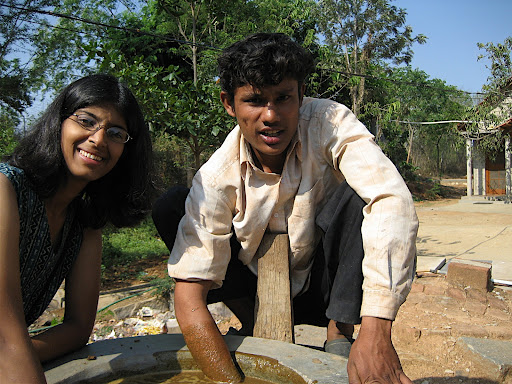
They have about 20 heads of cattle now and their cowdung is used to run the gobar gas plant. Theirs has been functional for about 4 years and supplies the energy required for cooking. It is a fixed dome model (deenbandhu model) and the slurry drains off into one of two composting ponds. One of them was full and they would soon use it as manure.
They use about 65 kgs of cowdung everyday to create methane gas. I had no idea 20 heads of cattle produce that much, in fact more since they go grazing too, cowdung! Every morning at around 9, the people taking care of the cattle cart in the gobar and mix it in the tank with water. The dung needs to be mixed well. This is done manually and I also put my hand in. I was glad it didn’t feel dirty, though my hand had a distinctive gobar smell for the rest of the day, or maybe it was all in my head!
Solar energy
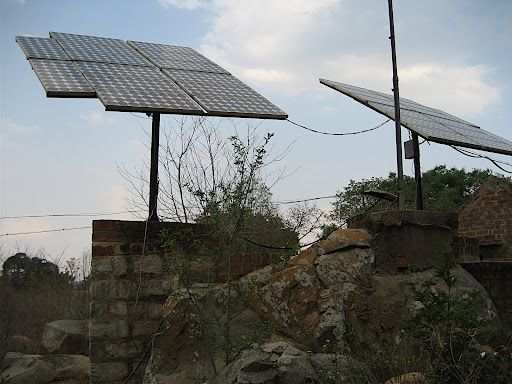
ND uses solar power for lighting, pumping water and for hot water. None of the buildings there have fans. They have been constructed in a manner that keeps them quite breezy and pleasant even in summer. Solar power is also used for the electric fence. They have had a bunch of panels for about 12 years now. They came with a10 year warranty and were supposed to work for 20 but they seem to be breaking down now. Om was a little disappointed with their performance given the high input costs and was talking about exploring more into using oil made from honge seeds for their energy needs.
Honge seeds
Oil extracted from honge seeds is used instead of diesel to provide energy. At ND, they run the generator on honge oil and it provides energy to the grinding machine that is part of their health foods unit. ND does not have many honge trees and they purchase the honge seeds from the nearby villages. The day I was leaving, the generator had broken down because the honge oil was too thick and had some drops of water. I am not sure if this is a regular feature or a one-off incident since I did not get a chance to talk to Om and Ananthu about it. These could be some problems associated with using honge oil.
Wind energy
ND currently has one windmill. It is a relatively new entrant into their experiments on alternate energy. Based on the wind velocity, it can generate up to 400W of power but on an average it produces about 150W. The power from this was used at Ananthu’s house for lighting, powering up a computer and an occasional use of a mixer. The entire unit cost about Rs 70,000 and was imported from China since India right now has good working models for commercial windmills but not for smaller ones like what they have installed. The investment seems to be high. I am not sure how this can be adopted extensively. Perhaps there are subsidies, I haven’t looked and didn’t ask Ananthu.
Dry composting toilets
The next couple of days, I watched Partapji spend time tending his garden and helped him plant some cotton seeds all along the fence. I even earned a quarter of a rupee for using his dry composting toilet. He has been trying to promote it among the people living in ND since currently most of the rooms there are equipped with flush toilets and he finds it incredulous that we waste gallons of good water to flush down our solid waste. Moreover septic tanks, the model used to deal with toilet wastes in many places, are a pain (Heres how they work). Someone needs to clean them eventually.
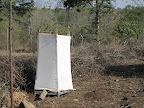
His composting toilet is by design mobile. It was a simple frame with a canvas covering the on 4 sides. He digs a pit about 2 feet deep and covers the humanure with mud each time, to avoid flies. Since it is so shallow, it should not contaminate any water sources. Once it is full, he leaves it alone for about 3 months and then plants a tree at the spot! If you are really looking for alternatives, so many surface I guess! Folks interested in learning more about dry composting toilets should read Joseph Jenkins The Humanure Handbook. It is available here.
Chat with Partapji

It was a rather cloudy afternoon and I didn’t want to miss out an opportunity to walk in the beautiful campus. So I headed out. A bunch of people were working on putting a fishing net on the drying platform so birds wouldn’t eat the grain that was put out to dry. I saw an older person with a flowing white beard working with them. I hadn’t seen him before. Soon Ananthu walked over and introduced me to him. He was Partap Aggarwal, another founding member. Some basic introductions and a mention of sustainable development ensued. Partapji immediately said there was nothing to development. All that mattered was for me to figure out what kind of life I would like to live. I had been expecting such a reaction from someone about the term development and here it was. It didn’t bother me. In fact, I couldn’t agree more with him. It was anyway an interesting way to start off a conversation. Soon I tagged along with Om, Ashwini and Partapji to check a point to dig a bore well. Om and Ashwini were working on clearing the area to provide some space for the machine and I started talking to Partapji.
He told me how this place was a dense forest only a few decades ago and how it is now very close to desertification. Left to him, I felt, he would have just let the place be with no human intervention. We got talking more about this and he said the current state was due to cultivation…organized farming. I had heard this opinion earlier from Bob Jensen but that occasion had not allowed further discussion. I wasn’t too happy to hear something negative about farming, with my current belief that small-scale farming is sustainable but was curious about his opinion on this matter. He simply said that the unsustainable cities we see and live in today are but a natural consequence of agriculture. Agriculture made it possible for hunter-gatherers to move towards hierarchical societies and cities are just a manifestation of this historical agricultural revolution. Our desire to control nature has resulted in us occupying enclosed spaces, cut off from nature. This has made us encourage highly unsustainable systems – systems that exploit nature, people and other forms of life.
So what happens next, I ask. Well, the system will collapse. All past civilizations have fallen and so will ours. The conversation was taking a turn towards the inevitable doomsday scenario, as I saw it, and I found myself resisting. He was calmly explaining why it was natural that such a cancerous system collapse. I said it did not sound optimistic. His response was that it could not be more optimistic than to hope that a tumor in your body collapses. Wouldn’t you want to get rid of the tumor as soon as possible, he asked me. I would rather hope we change how we live, I said. Which he immediately replied was exactly what he was talking about! Oh well, I guess so, I said but the whole inevitability is leaving a sense of despair in me. So I got a good pep talk.
P: There was nothing to be depressed about. The first thing is to realize that you are not running the world. That takes away most of the expectation and hence the depression.
A: That’s all alright, but if what I do does not matter in the larger scheme, why bother?
P: Just because you are an ordinary human being, like everyone else, it does not absolve you of responsibility. You need to work on doing the right thing, as you see it, but not be under any delusions that you are saving the world. Just the fact that you can even lead your life in the way you think it should be is important. You ought to feel privileged you are out visiting places and learning, whereas most people will never be able to do this.
A: Ok. But how do you then tackle forces like the SEZs?
P: Well, I don’t support them. And I think it is important for you to voice your opinion against them in whatever way you can. But don’t make your life a string of protests alone. You need to have something meaningful going on, something positive. If you are interested in living off the land, then that could be the source of your positive energy. Live on the land, try different sustainable ways of living. Provide people with an alternative so that when people listen to your protests and say ‘ok, what do you want us to do instead?’, you have something to show.
This got me thinking about how Bharathi Trust, Lok Samiti in Mehdiganj were all protesting different systems in the mainstream society but they were at the same time working on creating a society they want to live in. Bharathi Trust is doing this through its Resource Center. Lok Samiti has not only been fighting Coca Cola, they have also been working with the community in questioning certain social norms. They recently arranged group marriages for poor people who cant afford dowries, sending the message that one can find a partner in a simple, dignified manner.
Back to our chat. As long as we feel we need to control Nature, our efforts of small scale farming will not lead to much, he said. Only when we feel a part of Nature, will we able to listen and learn from her. So what does he think of natural farming. He said he had worked on it for 8 years at Rasulia and I was wondering where I had heard that before. Ah, he wrote the foreword for Fukuoka's One Straw Revolution! He answered in the positive and then the conversation turned towards his experience there. He believes that if you listen to Nature, you will not come up technologies that are unsustainable. You first need to realize that you are nothing. He mentioned Fukuoka’s spiritual experience that sent him on his quest of natural farming. The sun had set by then and we slowly walked back towards our rooms. It was a pleasure talking to this down-to-earth, 76 year old whose enthusiasm just rubs off on you.
Health Food Unit - why aren't whole grains the norm?
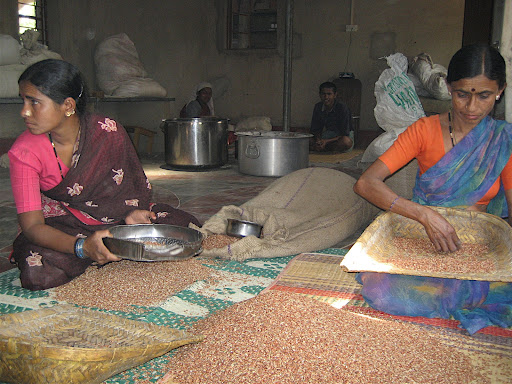 ND supplies many healthy, wholesome products through different outlets in Bangalore (Namdhari stores and homes of friends). They are trying to encourage the consumption of nutritious grains and millets that have been forgone by people in many parts of India.
ND supplies many healthy, wholesome products through different outlets in Bangalore (Namdhari stores and homes of friends). They are trying to encourage the consumption of nutritious grains and millets that have been forgone by people in many parts of India.
The staple diet for most people was not white rice. Many rural communities ate millets like ragi and jowar and various varieties of rice that were not necessarily polished. The same holds for dals. Eating polished dals was not always the norm. People worked their digestive systems by feeding them wholesome grains. As Fukuoka says in his book One Straw Revolution, our bodies did all the work that current day mills do!
So how did we get fixated with white rice? The PDS (Public Distribution System) in India was instituted to provide subsidized food grains to people. And the reductionist thought that went into making it also decided that all people could eat white rice. People had access to cheap foodgrains and soon got used to polished, white rice. In Sittinlingi (where we spent time at Thulir), the community was quite cut off from mainstream society till it got a road to Salem. People used to eat a kind of gruel made from ragi along with sundal for their protein. Most of these were grown on their own farms. With the coming of the ration shop, they had access to cheap rice (Rs. 2 / kg currently) and hence had less reason to grow their own food. Slowly, there is a trend of growing cash crops and using the returns to buy food from the ration shop. It is the same case in the Baligi Kandriga region where Bharathi Trust has started the resource center. People have adopted cheaper, less nutritious diets. The situation is no different in Gumalapuram. I was chatting with some of the women who work in ND’s health food unit. While they still grow some ragi for their own consumption, they have all switched to white rice. Unpolished, red rice that ND dehusks and packages sells at Rs. 25 a kg – much more expensive than what the ration shop can provide.
Why don’t they sell unpolished rice at least? Ananthu told me about his experience in getting the white rice dehusked but not polished. The person he approached for this agreed to do it but said he would be charged a fee to which Ananthu agreed. He then saw farmers bringing in paddy to be polished and not getting charged at all. On enquiring about this seeming injustice, the mill owner responded saying the pharmaceutical companies would pay him much more for the rice bran. They make their vitamin tablets from it. So we eat polished rice with not much nutritional value and those who can afford it, get their daily dose of vitamins from vitamin pills!
Back to ND. Not many of the grains are grown at ND, the soil still has not recovered enough to support agriculture. They have grown some ragi in the past and will be planting some this season too. Some of the local farmers have started growing red rice organically and supplying it to ND. ND members go to the farms and work with the farmers about organic methods etc. They don’t actively campaign a switch to organic farming but support farmers who go organic by purchasing their produce. Most of the people who come to work at ND from the village nearby own some land. Over the years, after observing how ND has been working to grow food organically, some of them have started using lesser and lesser urea, which I thought was great. Such organic work takes its own time.

They make different products: whole wheat atta, ragi flour, sprouted dalia, sprouted suji, red rice, dry idli and dosa mixes using red rice (the idlis have an interesting purplish tinge), turmeric, chilli powder, jaggery, pickles, gheeless sweets, chyawanprash, honey, and lime juice concentrate are some that I remember. The food I ate at ND was tasty, wholesome and not oily. They served ragi muddais and red rice for lunch and different items were served for dinner and breakfast. They prepared a large quantity of the vegetable dish, very different from my other visits where I was served more grains. I later learnt of their health food ideology that stresses on the importance of a lot of veggies in your diet. In fact, according to Partapji, we would do just fine on fruits and veggies. Our bodies can’t really handle grain, hence we need to grind them, soak them, boil them etc in order to be able to eat them. I guess if that much work is to go in just to eat a particular kind of food, you don’t really have to eat it! Not sure I can give up my latest craze, set dosa but I agree about not needing so much grain.
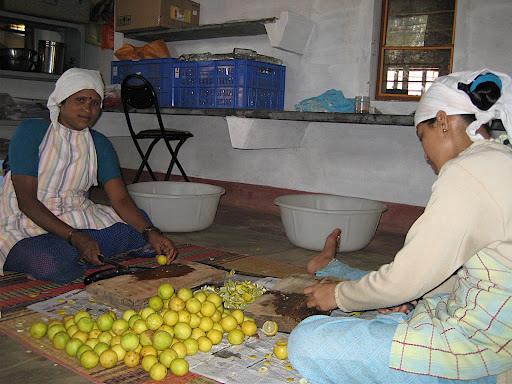
The green canopy
Today, Navadarshanam is home to thousands of trees, most of which have taken root naturally. The first thing that was done when ND was started was to stop cattle from grazing on the land. In most places, forests were cleared making way for agriculture. Intensive agriculture soon led to loss of soil fertility and the lands were then used for grazing cattle. This leads to further degeneration of land since cattle just eat up saplings. Apparently sheep and goats create much of the problem, while cows are selective about what they eat and are thus not harmful to saplings. In this area, once agriculture failed, one of the international agencies (I forget which one) provided funds to the people to purchase livestock. The communities invested in sheep and goats and a lot of the region is bare due to this. Makes me think of Marx’s quote: the road to hell is paved with good intention!
Fencing off the land to grazing was not trivial. The local community did not understand their logic. They were not growing anything there and they certainly did not have any cattle (They did not want their own cattle damaging the vegetation. They purchased cattle after 6-7 years). So what were they doing with the land? It was tough and people sometimes cut off the fence to graze their cattle but the extent of grazing was much lesser and soon the land was covered with lantana bushes. This provided a protection cover for other saplings and soon different types of trees started growing there – the doing of birds. Over time, the lantana bushes committed suicide, as Ananthu put it! He is a strong believer in Nature’s patterns and was explaining how each year something different grows – it is almost like Nature knows what the land needs.
They might have somehow made their neighbors understand their philosophy about grazing, but when tuskers from the Thally reserve trampled through the land, nothing could be done. Saplings just died under their feet. This was when they decided to get an electrified fence that produces a pulse of very high voltage but small current and hence provides a shocking sensation that is not harmful. I was too chicken to touch it…maybe next time!
They have planted some fruit bearing trees but have taken the effort of not turning them into monoculture orchards. You would see guava, chickoo and mango all planted near each other since they argue that each of these trees require different nutrients and thus would not compete with each other.
Chat with Jyothi, Ananthu and Om
So what was I doing in ND? I told them a little about myself and my interest in sustainable living. The current scenario of liberalization, structural adjustments, SEZs are both causing small scale farming to be unviable and proceeding on further industrialization etc because small farming is unviable. So are there any alternatives - can we think small and work on sustainable initiatives that will help us grow without exploiting nature and other human beings? It seemed to me that ND was experimenting with such alternatives and I was there to learn about their efforts. This led to talking about how ND was started.
Some of the folks I met at ND - Jyothi, Ananthu, Om and Partap, are founding members. Jyothi and Ananthu were based in Delhi in the 70s and 80s. Ananthu, an engineer worked for a few years in the corporate world and then moved to the Gandhi Peace Foundation. Jyothi was a sociologist by training and taught at IIT Delhi. In Delhi, they started a study group where they analyzed the current system and discussed alternatives. Through this group, they came in touch with others with similar interests. Partap Aggarwal had been experimenting with alternatives for a few decades. An anthropologist by training, he taught for a few years at Colgate University before moving to India. In India, among other things, he worked for 8 years at Rasulia, experimenting with natural farming or ‘rishi kheti’. Jyothi, Ananthu, Om and Partap met at Atheetha Ashram (from what I gathered, their spiritual camp in those days) and decided to work together towards seeking an alternative to the unsustainable urban life. About 105 acres of land was identified near the Anekal area and the Navadarshanam Trust established. The land, that had been a thick forest 80 years ago, had degenerated due to deforestation for timber, intensive agriculture and finally unchecked grazing. They decided to work with the land and try and revitalize it with the larger spiritual goal of inner quest.
They function on an ideology of wholeness. At both the level of the body and the mind, each of us is an individual, separate from the other. It is at the level of life that one realizes the oneness with all beings. Such a connection, they believe, would lead to new technologies that would provide us with better lives and not exploit nature and hence other human beings.
While most of the founding members wanted to stay at ND and work together, many of them were unable to do so due to different commitments. Jyothi and Ananthu, who had by then moved to Whitefield, near Bangalore, became the coordinators and started managing the day-to-day activities. A couple of things tied them all together: their spiritual growth and Fukuoka’s One Straw Revolution. They wanted to practice natural farming and most of them had no idea how to go about doing it. Partap had worked on it at Rasulia but he was unable to spend much time at ND. They had a very resourceful person in Sunny who put his heart into it but for some reason it didn’t work. It could be that the land needed more time to heal or as Partapji mentioned at a later conversation, that there was a search for immediate results and natural farming requires one to have a different mindset. They have had success with the fruit trees though. They then started the health foods initiative to work towards self-sustenance. Looking back, they say that it was a learning experience in adapting to the situation while functioning within their ideological framework.
On my way to Navadarshanam

I started out for Navadarshanam around 10 AM on a Monday morning and it didn’t take me long to realize what a blunder that was! I was hoping to ride the bus to Majestic (the bus terminal in Blore) and then catch a bus to Anekal. There was no way I could squeeze in with my two bags, well, at least I didn’t want to try it. Found an auto after some time and he told me it was much easier to take the bus to Anekal from the Silkboard – much closer. The bus to Anekal came along pretty soon and in about 50 minutes, we reached Anekal. I took an auto from there to Gumalapuram, where Navadarshanam (ND) is located.
I had heard about ND from Anita B and then from some Asha Bangalore volunteers. In fact, when I asked Gaurav’s mom where to get the awesome dalia I had at their place, she took me to Namdharis. I was very surprised to see it was a Navadarshanam product. They supply a few wholesome products like red rice, sprouted dalia and ragi to the Namdhari chain of stores in Bangalore. Their website has quite some information - they seemed to be trying out some alternatives in housing, energy and living and I got curious. I called ND about staying there for 4-5 days and Jyothi said it wouldn’t be a problem.
I reached ND around 1:30 and there were about 10-12 people having their lunch. I joined them and kicked off my stay with ragi muddai and some tasty sauce. Jyothi and Ananthu had gone to Blore and would only return at night. I was taken to my room in Manjari and I spent the entire afternoon in the balcony reading. The balcony overlooks an expanse of greenery and there’s always a breeze blowing. Around 5 in the evening, it got very pleasant and I went out for a walk. The ND trust looks after about 105 acres of land and I stumbled upon various paths. I was finally pointed to the periphery road, which is 2.5 – 3 km long. I walked some distance, deciding to put my running shoes to use here the next morning. Watched a beautiful sunset and walked back for dinner. Just as I was finishing my dinner, Om, Ananthu and Jyothi got there. After some introductions, we decided to get together the next morning to talk about what I was doing there.